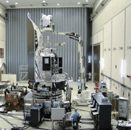

PRODUCT NEWS

KISTLER SENSORS PROTECT ESA SATELLITES DURING TEST.
Anyone who has watched a satellite launch live or on TV will realise that everything on board the launch vehicle is exposed to heavy vibration. To make sure European Space Agency (ESA) satellites and components can survive the extreme loads experienced during the launch phase, vibration test facilities have been in operation for several years at the European Space and Research Test Centre (ESTEC) in the Netherlands. From the beginning, Kistler has been a major supplier of force sensors used to monitor and control the shaker systems.
The latest installation involves 24 Kistler Type 9377B force links integrated between the shakers and the satellite adapters to monitor the forces and moments being transmitted to the test specimen. Although the acceleration at the specimen interface is controlled, to prevent damage to the specimen when resonance frequencies are reached, it is essential that the forces and moments are limited. The charge outputs of the 24 force links are conditioned by 72 charge amplifiers controlled by dedicated PC software developed by Kistler specifically for this application. The outputs from the charge amplifiers are combined in real time by an ESTEC developed computing unit to generate three forces and three moments. These signals, together with directly measured acceleration signals, are fed to the vibration control console to maintain the excitation level within safe parameters.
Several vibration facilities are operated at ESTEC to cover the large range of specimen size: The smallest system is an 80 kN electrodynamic shaker used for specimens up to a few hundred kilos. The mid range system is a multishaker system equipped with two 160 kN shakers to test specimen up to 5 tons. Finally, a large 6-DOF (Six Degrees Of Freedom) hydraulic platform is used for large specimens up to 25 tons.
______________________________________________________________________
September 2007
Home - Search - Suppliers - Links - New Products - Catalogues - Magazines
Problem Page - Applications - How they work - Tech Tips - Training - Events